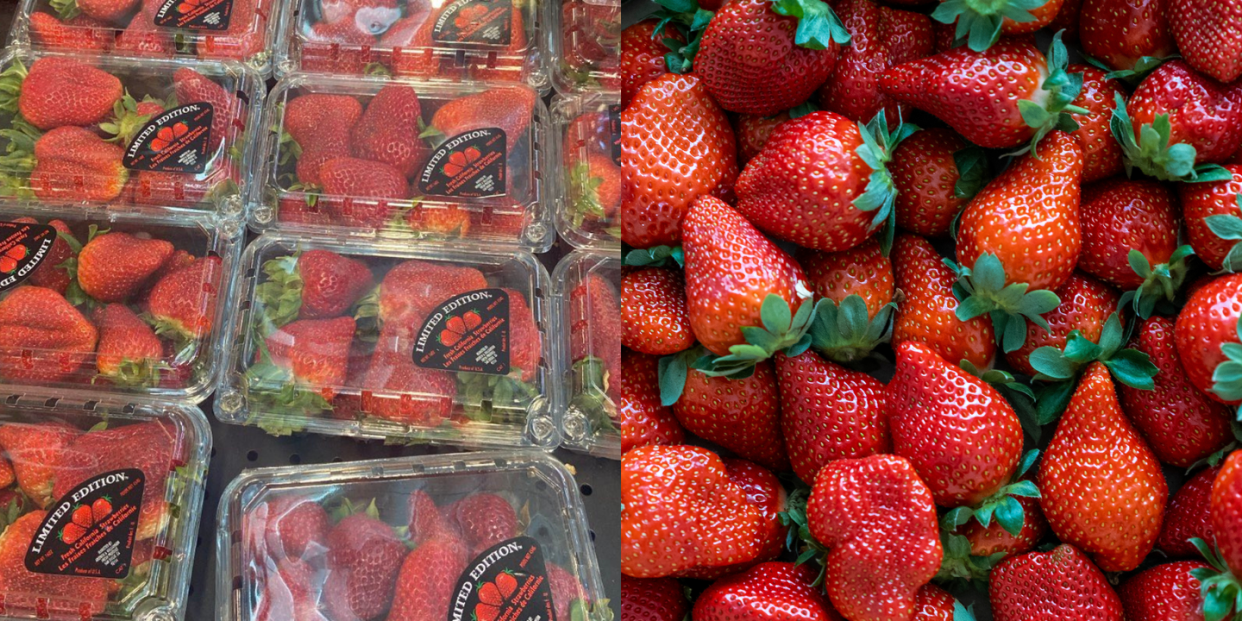Are Supermarket Strawberries Giant Now Or Is It Just Us?

There’s a lot to look forward to when it comes to summer: backyard BBQs, beach trips, and the best produce the season has to offer. Some of our favorite fruits and vegetables are at their peak in the summer months. We love cooking with corn and tomatoes, but let's be honest: Strawberries might just be the best food you can enjoy all season.
However, when going to the supermarket to pick up a pack of berries recently, I noticed something different. They’re massive. The first time I spotted a container of gargantuan strawberries, I chalked it up to the supermarket’s stock.
Then I went to a different store a few days later only to be faced with the same exact dilemma. No worries, I thought, I’ll just check the organic section. But even those strawberries were giant!
Within the span of a few days, I had experienced these giant strawberries, multiple friends mentioned the same phenomenon (unprompted, might I add), and then I saw this tweet:
what did they do to the strawbs pic.twitter.com/V9UzURMqG8
— Kyla Scanlon (@kylascan) May 30, 2023
Surely this can't be a coincidence, right? I asked around our office to see if they were experiencing the same thing.
“YES!” said our director of content operations Lindsey Ramsey. “I bought some to make our strawberry spinach salad and only needed to slice up two and was like, um…”
Our associate SEO editor Allison Arnold chimed in, “I feel like every container (organic or non-organic) has just a few massive abnormal-shaped strawberries.”
Strawberries have gotten so big that the daughter of our editorial business manager Megan Belair has to take several bites out of them as if they were an apple.
Clearly, the few containers I’ve encountered at the grocery store aren’t just a fluke. So I tasked myself with the mission to find out why our strawberries have ballooned in size recently. While representatives from major berry companies didn't respond to requests for comment, I did get some insights from strawberry experts.
I chatted with Dr. Mitchell Feldmann, Director Elect of UC Davis’s renowned Strawberry Breeding Program. In over half a century, UC Davis's program has developed over 30 varieties of the fruit and licensed them to growers. The patented varieties created at UC Davis comprise around 60 percent of the strawberries sold in the entire world.
I also spoke with Dr. Jayesh Samtani, Associate Professor and Small Fruit Extension Specialist at Virginia Polytechnic Institute and State University. Samtani dedicates much of his work towards optimizing berry production and determining the best that grow in Virginia and the surrounding region.
Like with any type of plant, the quality and size of strawberries partially relies on the natural environment—specifically the heat. “We had a really extended cool winter and cool spring with a lot of water [in California],” Feldmann says. Similar weather patterns happened this season on the east coast, according to Samtani. "The temperatures in May and June have been relatively cooler, which resulted in an extended harvest," he says.
Generally speaking, cooler temperatures and increased exposure to moisture in the soil beds can contribute to larger fruit come harvest season. “These can help increase strawberry size, but it’s not guaranteed," says Feldmann.
A more reliable factor to consider with strawberry harvests is the variety being used. Both UC Davis’s public program and private ones like Driscoll’s cross-pollinate different varieties to create the best berries. And for the current commodity strawberry industry, the best berries are on the larger side.
But why do we want strawberries to be this big in the first place? According to Feldman, there are a lot of factors at play. Laborers at strawberry farms are paid for each clamshell they fill with fruit. So the fewer berries it takes to fill a box, the more efficient and lucrative the process becomes. And on a practical level, big strawberries are simply easier to find and pick. "You can pick more weight by moving your hands less," Samtani adds. "It translates to reduced labor in harvests."
Larger berries are also more hardy. They can handle cold storage and traveling for days or even weeks before reaching your produce department. Unlike the locally grown heirloom varieties from your nearby farmers' market, these berries are designed specifically to be stocked on supermarket shelves from coast to coast.
Some may argue that bigger strawberries are also more appealing to the average consumer. "It may look more attractive, but it depends on the age group," says Samtani. "Most children actually prefer their berries to be on the medium to small side so they can eat them in fewer bites." And, as it turns out, even some adults are spooked by the bigger berries.
The current harvest seems like a massive change for the average consumer. But in actuality, the overall shift in strawberry yield is more incremental. The strawberries of years past could, in fact, reach the same size as the ones we’re seeing today—but many of them didn’t due to the way they were grown on an industrial scale.
“With new varieties, we don’t know the best management practices,” Feldmann says. “Over time, farmers learn and discover the best practices so the fruit can reach its genetic potential.”
So for all the skeptics out there, farmers aren't bulking up our berries with synthetic chemicals. Instead we can thank the weather, strawberry breeding, and good farming techniques whenever we enjoy our sweet summer desserts.
You Might Also Like


